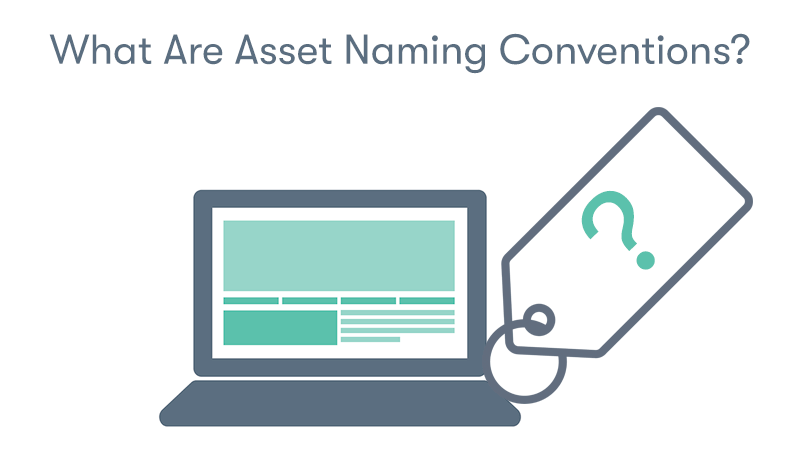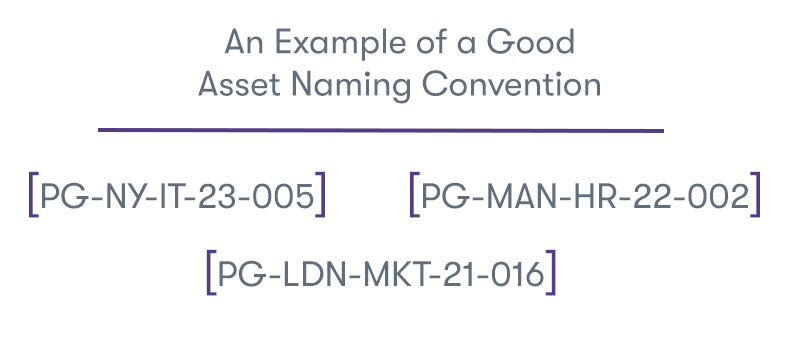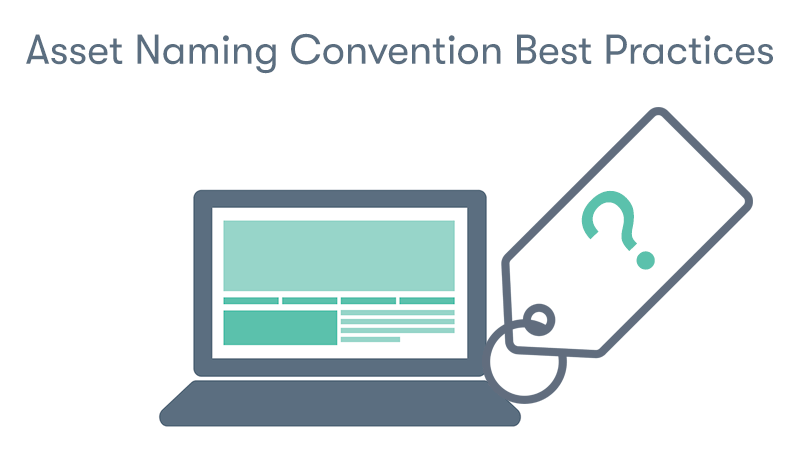Asset Naming Convention Best Practices
Welcome to our insightful exploration of Asset Naming Convention Best Practices, a critical yet often overlooked aspect of IT management. In the complex landscape of modern technology, the clarity and organisation provided by effective asset naming are indispensable for efficient IT operations. Whether you're managing a vast array of hardware, software, or digital resources, a well-structured naming convention is the linchpin for seamless asset tracking, security, and compliance.
In this blog, we delve into the core principles and strategies that define the best practices in asset naming. We aim to equip you with the knowledge to implement a system that enhances operational efficiency and aligns with your organisation's unique needs and growth trajectory.
Let's embark on this journey to organisational optimisation through strategic asset naming.
What is Asset Naming?
IT Asset Naming refers to giving unique, identifiable names to various IT assets. These assets include hardware (like servers, workstations, and network devices), software applications, and sometimes digital documents or resources.
Asset naming ensures that each item can be easily and unambiguously identified for various purposes, such as tracking, maintenance, and security. Key aspects of Asset Naming in IT include:
Uniqueness
Each asset should have a distinct name to avoid confusion and overlap. This is crucial in large organisations where there are many similar assets.
Standardisation
Many organisations follow a standard naming convention. This might include location codes, department codes, asset type identifiers, and sequential numbers.
Scalability
The naming convention should be scalable and flexible enough to accommodate new types of assets and organisational changes.
Clarity and Meaning
Names often include abbreviations or codes that convey information about the asset, such as its type, primary user, location, or network to which it belongs.
Ease of Use
Names should be easy to remember and use to facilitate communication among IT staff and other employees.
Integration with IT Management Systems
Asset names should be compatible with the organisation's IT asset management systems for tracking and reporting purposes.
Effective asset naming helps manage IT resources efficiently, enhances security, simplifies troubleshooting, and supports effective asset lifecycle management.
What Are Asset Naming Conventions?

Asset Naming Conventions in IT refer to a systematic approach to naming assets (like hardware, software, and digital resources) that ensures consistency, clarity, and ease of identification across an organisation. These conventions are crucial for effective asset management, particularly in larger organisations with substantial volume and variety of assets. Key elements of Asset Naming Conventions include:
Structure
A well-defined structure that usually includes a combination of meaningful abbreviations, numbers, and sometimes special characters. This structure helps identify the asset type, location, department, or other relevant attributes.
Standardisation
Consistency in how assets are named. This standardisation ensures that anyone in the organisation can understand what an asset is, where it's located, or to whom it belongs just by looking at its name.
Scalability
The naming convention should be capable of accommodating growth. It should be flexible enough to include new types of assets or changes in organisational structure without becoming overly complex or needing a complete overhaul.
Uniqueness
Each asset should have a unique identifier to avoid duplication and confusion, which is critical for tracking and managing assets effectively.
Clarity and Simplicity
Avoid overly complex or cryptic naming conventions. The names should be easily understandable and communicable, especially when rapid identification is necessary.
Compatibility
Names should be compatible with the organisation's IT systems, databases, and any relevant software tools used for asset management.
Compliance and Security
Adhering to regulatory compliance requirements related to asset naming and ensuring that the naming convention does not unnecessarily expose sensitive information.
Documentation
Maintaining clear documentation of the naming convention is vital for new staff training and for maintaining consistency over time.
What Are Asset Naming Convention Best Practices?
Adopting best practices in asset naming conventions is crucial for effective management and tracking of IT resources in an organisation. Here are some of the best practices for developing and implementing asset naming conventions:
Simplicity and Clarity
Keep the naming convention simple and understandable. Avoid overly complex or cryptic names that might confuse users and IT staff.
Consistency
Apply the naming convention uniformly across all types of assets. Consistency helps in the easy identification and management of assets.
Uniqueness
Ensure each asset has a unique name to avoid confusion and facilitate precise tracking. Duplicate names can lead to errors in asset management.
Descriptive and Meaningful
Include descriptive elements in the names that provide helpful information about the asset, such as its type, location, function, or owner.
Scalability and Flexibility
The naming convention should be scalable to accommodate growth and flexible enough to include new types of assets or organisational changes.
Standardisation
Adopt standardised abbreviations and formats within the naming convention to maintain uniformity.
Avoid Ambiguities
Refrain from using ambiguous terms or characters that could be easily misinterpreted or confused, like '0' (zero) and 'O' (the letter O).
Compliance with Organisational and Industry Standards
Align the naming convention with any organisational policies and industry standards, including security and privacy considerations.
Documentation and Training
Document the naming convention guidelines clearly and provide training to relevant staff. Good documentation ensures that the convention is applied consistently and understood by all appropriate parties.
Integration with IT Management Systems
Ensure the naming convention is compatible with the organisation's IT asset management systems for effective tracking, reporting, and management.
Regular Review and Updates
Periodically review and update the naming convention to ensure it remains relevant and effective as the organisation's needs and technologies evolve.
Avoid Sensitive Information
Do not include sensitive information in asset names that could pose security risks, such as explicitly indicating a high-value or critical system.
Length Considerations
Keep the length of the names manageable. Too long names can be cumbersome, while concise names might not provide enough information.
Use of Special Characters
Be cautious with unique characters as they might not be compatible with all systems or have specific meanings in certain contexts.
By following these best practices, organisations can ensure that their asset naming conventions contribute effectively to their IT infrastructure's management, security, and operational efficiency.
Why is Asset Naming Important?

Asset naming is a critical aspect of IT management for several reasons:
Asset Identification and Tracking
Proper asset naming allows for easy and accurate identification of IT assets. This is particularly important in large organisations with numerous and diverse assets. A straightforward naming convention helps track these assets throughout their lifecycle, from acquisition to disposal.
Simplified Troubleshooting and Maintenance
When an issue arises, quickly and accurately identifying the affected asset is essential. A well-defined naming convention can convey helpful information about the asset, such as its location, purpose, or primary user, which aids in faster troubleshooting and maintenance.
Enhanced Security
Asset naming plays a role in security management. Knowing exactly what assets you have and being able to identify them readily is crucial for assessing vulnerabilities, implementing security policies, and responding to incidents.
Efficient Asset Management
Asset naming conventions facilitate better asset management practices, including inventory management, auditing, and reporting. Tracking the quantity, status, and configuration of assets across the organisation becomes more effortless.
Compliance and Governance
Many industries have regulatory requirements regarding the management and tracking of IT assets. A systematic asset naming approach helps ensure compliance with these regulations.
Cost Management and Optimisation
Effective asset naming aids financial management by providing a clear view of the organisation's assets. This clarity is beneficial for budgeting, cost allocation, and identifying opportunities for cost savings (like reducing redundant assets).
Facilitates Scalability
As an organisation grows, so does its inventory of assets. A scalable naming convention can accommodate this growth, making integrating new assets into the existing framework easier.
Improves Communication
Within an IT team and across departments, a common naming standard aids in clear communication. When everyone uses the same terminology, it reduces misunderstandings and improves collaboration.
Disaster Recovery and Business Continuity
In the event of a disaster, having a well-organised asset naming system can expedite the recovery process. It allows for quicker identification of critical assets that need to be restored or replaced.
Supports Automation and Integration
With the increasing use of automated IT management tools, having a standardised naming convention is essential. It ensures compatibility and efficiency in integrating various IT systems and management tools.
In summary, asset naming is not just a matter of administrative convenience. It is a foundational practice for effective IT governance, security, and operational efficiency.
An Example of a Good Asset Naming Convention

A good laptop asset naming convention should be structured, descriptive, and scalable. Here's an example of a naming convention that incorporates several important elements:
| Naming Convention | Description |
| Company Initials | The initials of your company or organisation. For example, "PG" for Purple Griffon Ltd. |
| Location | A code representing the location where the laptop is primarily used. This could be a city code, office code, or floor number. For instance, "NY" for the New York office, "LDN" for the London office, etc. |
| Department | An abbreviation for the department to which the laptop is assigned. For example, "HR" for Human Resources, "IT" for Information Technology, and "MKT" for Marketing. |
| Year | The year of acquisition or assignment to a user. For example, "23" for 2023. |
| Sequential Number | A unique sequential number, starting from 001 for each location and department combination each year. This helps in identifying each laptop uniquely. |
Which would equate to: [CompanyInitials]-[Location]-[Department]-[Year]-[SequentialNumber]
For example, a laptop assigned to the IT department in the New York office of Acme Corporation, purchased in 2023, might be named "PG-NY-IT-23-001".
This convention is beneficial because it:
- Provides Quick Information: Immediately, you know the company, location, department, and year of the laptop.
- Ensures Uniqueness: The sequential number ensures each laptop has a unique identifier.
- Is Scalable: New locations, departments, or years can be easily added.
- Is Easy to Understand and Implement: It’s straightforward enough for all employees to understand and use.
- Facilitates Management and Tracking: This system makes it easier to track and manage laptops, especially for IT support and asset auditing.
Remember, the best naming convention depends on your organisation's specific needs and structure. The key is consistency and ensuring the convention meets your organisational needs.
How Does Asset Naming Relate to ITIL?
Asset naming relates to ITIL4 primarily through its Service Asset and Configuration Management (SACM) practices. ITIL4, a set of best practices for IT service management (ITSM), emphasises the importance of effectively managing IT assets to deliver high-quality IT services. Here's how asset naming ties into ITIL4:
Configuration Management Database (CMDB)
In ITIL4, the CMDB is a vital component that stores configuration items (CIs), including all relevant IT assets. A clear and consistent asset naming convention aids in accurately identifying, documenting, and managing these CIs in the CMDB.
Service Asset Management
ITIL4 focuses on service assets, which are the resources and capabilities used to deliver services. Proper asset naming ensures these assets are easily identifiable, trackable, and manageable, which is crucial for efficient service delivery.
Change Management
Accurately identifying the affected assets is crucial when changes are made to IT services or infrastructure. A standardised asset naming convention aids in clearly identifying which assets are involved in a change request, minimising errors and confusion.
Incident and Problem Management
In resolving incidents and problems, IT personnel must quickly and accurately identify the affected assets. A well-defined asset naming system allows for faster identification, leading to quicker resolution of incidents and problems.
Audit and Compliance
Asset naming conventions facilitate compliance with audit requirements by making tracking and accounting for all IT assets easier. This is particularly important in environments where regulatory compliance is a key concern.
Asset Lifecycle Management
ITIL4 emphasises the importance of managing assets throughout their lifecycle. A consistent naming convention helps track assets from procurement to disposal, ensuring effective lifecycle management.
Risk Management
Understanding the assets within an organisation's IT environment is critical for assessing and managing risk. Clear asset identification through a naming convention aids in risk assessment and mitigation strategies.
In summary, in the context of ITIL4, asset naming is a foundational practice that supports various ITSM processes by ensuring that assets are consistently and clearly identified, tracked, and managed throughout their lifecycle. This practice contributes to the overall effectiveness and efficiency of IT service management within an organisation.
Final Notes on Asset Naming Conventions
In conclusion, this comprehensive discussion has highlighted the crucial role of asset naming in IT, a practice integral to effective IT management. We explored the essence of asset naming and its conventions, underscoring their significance in ensuring clarity, efficiency, and security in managing IT resources. From aiding in easy identification and tracking of assets to enhancing security and facilitating compliance, asset naming proves indispensable.
We delved into best practices and provided an illustrative example of a laptop naming convention, emphasising simplicity, descriptiveness, and scalability. Lastly, we connected asset naming to ITIL4, demonstrating its importance in Service Asset and Configuration Management.
Overall, Asset naming emerges as a fundamental aspect of IT governance, vital for the streamlined operation of any organisation's IT infrastructure.


